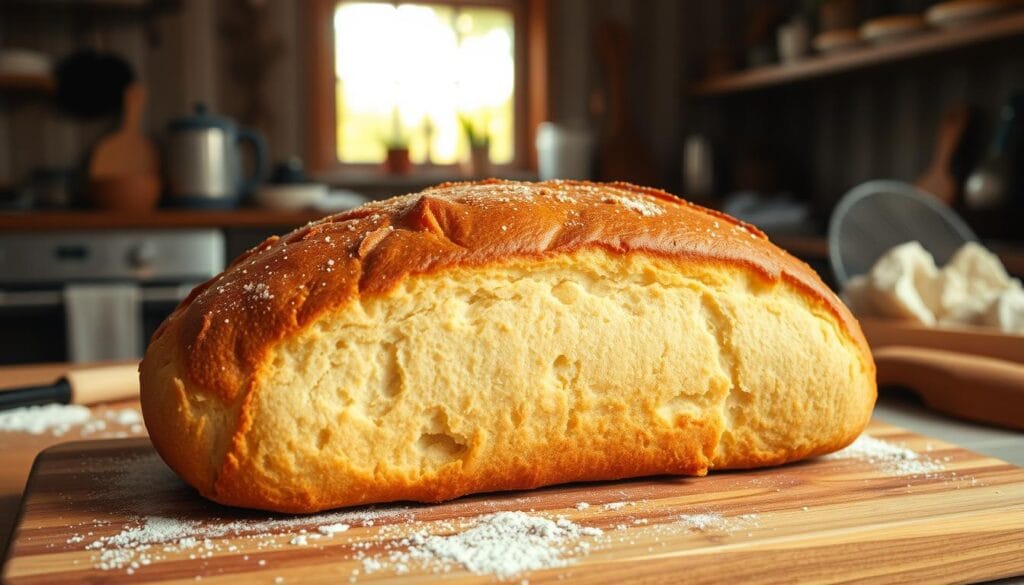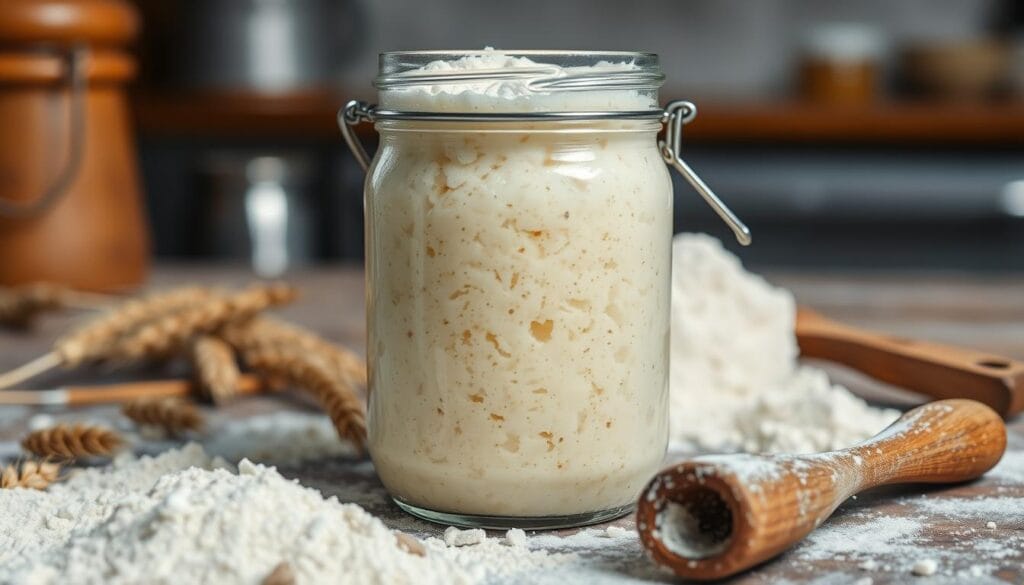The smell of fresh bread in the kitchen is a simple joy. It takes you back to your childhood. Maybe it was your grandma’s homemade loaf or Sunday morning breakfast. Today, I’m excited to share a simple recipe for sourdough sandwich bread you can make at home.
Understanding Sourdough Sandwich Bread Basics
Sourdough sandwich bread is different from traditional sourdough. It has a softer texture that’s great for sandwiches. This texture helps it hold fillings and toppings well.
What Makes Sandwich Sourdough Different
The main difference is in how it’s made. Sandwich sourdough ferments for a shorter time. It’s shaped tightly, making it finer and more even. This makes it sturdy for sandwiches but still tasty.
Benefits of Homemade Sourdough
- It’s easier to digest because of the fermented dough process
- It tastes more complex and rich than store-bought bread
- It lasts longer, so you can enjoy it for days
Key Characteristics of Perfect Sandwich Bread
The best sourdough sandwich bread is soft and pliable. It should not crumble or get too dense. It should also have a slight homemade sourdough bread tang. This adds a nice balance to the sandwich.

Essential Ingredients for Your Sourdough Sandwich Bread
To make tasty sourdough sandwich bread, start with the right ingredients. You’ll need an active sourdough starter, unbleached all-purpose flour, warm water, olive oil, honey, and kosher salt. These simple, natural ingredients make the bread taste great and can help those with gluten issues.
The sourdough starter gives the bread a tangy flavor. The flour adds structure, and the warm water makes the dough soft. Olive oil adds richness, and honey balances the sourness. Kosher salt brings out the flavors.
With these ingredients, you can make a homemade sourdough sandwich bread that’s soft and full of flavor. It’s perfect for breakfast, lunch, or dinner, like toast or grilled cheese.
| Ingredient | Quantity |
|---|---|
| Active Sourdough Starter | 1 cup (227g) |
| Unbleached All-Purpose Flour | 4 cups (500g) |
| Warm Water | 1 1/2 cups (355ml) |
| Olive Oil | 2 tablespoons (30ml) |
| Honey | 2 tablespoons (40g) |
| Kosher Salt | 1 1/2 teaspoons (9g) |
Using fresh, high-quality ingredients is key to making great artisan bread. By focusing on these essentials, you’re on your way to making a delicious sourdough sandwich bread that everyone will love.

Preparing Your Active Sourdough Starter
Making the perfect sourdough sandwich bread starts with a healthy starter. This mix of flour and water gives your bread its tangy taste and chewy feel. To get your starter ready for baking, follow these key steps:
Feeding Schedule and Ratios
Feed your sourdough starter 12 hours before mixing the dough. Use a 1:4:4 ratio – one part starter, four parts water, and four parts starters cultures. This slow rise in a 68-70°F kitchen lets the sourdough starter fully develop its flavor. For faster activation, try a 1:1:1 ratio.
Testing Starter Readiness
Watch your sourdough starter closely to see if it’s ready for baking. A mature starter will double in size and look bubbly and frothy. This shows the yeast is active and ready to make your bread rise.
Maintaining Starter Health
- Feed your sourdough starter at least once a day to keep it lively and healthy.
- Keep the starter in the fridge between uses, but feed it before baking again.
- Throw away some starter before feeding to keep the right ratio and avoid too much.
By following these steps, you’ll have a strong and dependable sourdough starter. It will be the base for your tasty homemade sandwich bread.
Required Equipment and Tools
Making the perfect homemade sourdough sandwich bread needs some key tools. You’ll need a strong, 9″ x 5″ loaf pan to shape your loaves. Also, a stand mixer with a dough hook attachment makes kneading easy.
A dough whisk or stiff spatula is vital for mixing all ingredients well. A wire cooling rack is also key for cooling your bread right.
Other tools that help include a Danish dough whisk for folding, a metal bench scraper for dough shaping, and a spray bottle for steam during baking. This steam helps get a crisp crust on your bread baking creations.

With these tools ready, you’re set to make tasty, rustic loaves of sourdough sandwich bread at home. Good tools make bread baking rewarding and efficient.
Step-by-Step Mixing Process
Learning to make bread baking starts with mixing the dough right. To make your tasty homemade sourdough bread, mix the ingredients in a stand mixer bowl. Use a dough whisk or your hands to make a shaggy dough. Let it rest for 1 hour to soak up the water.
Initial Dough Formation
After the dough has soaked up the water, it’s time to knead. Use your stand mixer’s dough hook to knead on low speed for 8-10 minutes. Or knead by hand for the same time. The dough should become smooth and shiny.
Kneading Techniques
- Start the mixer on low speed and let the dough hook work the ingredients for 1-2 minutes.
- Then, increase the speed to medium-low and knead for 10 minutes. Make sure the dough pulls away from the bowl sides.
- If kneading by hand, use a gentle folding and pressing motion. Work the dough for 8-10 minutes until it’s smooth and elastic.
Dough Consistency Indicators
The dough should look and feel like this:
- Smooth and Supple Texture: It should feel soft and pliable, without lumps or stickiness.
- Elastic and Stretchy: When you pull a small piece of dough, it should stretch without tearing.
- Shiny Appearance: A well-kneaded dough will have a subtle sheen, showing it’s ready.
| Statistic | Value |
|---|---|
| Cost per loaf | Roughly $1 |
| Recommended loaf pan size | 1.25lb USA Loaf Pan |
| Internal temperature range for bread | 195F to 201F |
| Starter sources | Basil & Bloom, Sadee’s Sourdough |
| Proofing time | 9-12 hours for dough to double in size |
| Baking time | 35 minutes at 375F |
Bulk Fermentation Guide
The secret to a tasty sourdough sandwich bread is the long fermentation process. This step lets the fermented dough get complex flavors. It also makes the dough soft and pliable, ideal for sandwiches.
Start by letting your dough rise in a warm spot, between 68-72°F. Let it rise for 10-12 hours or until it doubles in size. This long fermentation is key to bringing out the best in your sourdough starter. It makes the bread flavorful and easy to slice.
Remember, the fermentation time might change based on your kitchen’s temperature. If it’s cooler, you might need a longer rise. Warmer places can make it faster. Watch your dough closely and adjust as needed to get it just right.
| Total Dough Weight | 1,200 grams |
|---|---|
| Pre-fermented Flour | 5.00% |
| Hydration | 90% |
| Yield | One loaf in a 9″ x 5″ x 2.75″ pan |
By watching the bulk fermentation closely, you’re on your way to making a long fermented, fermented dough. It’s perfect for your homemade sourdough sandwich bread.
Shaping Your Sourdough Sandwich Bread
Making the perfect sourdough sandwich loaf starts with shaping the dough. This step makes your bread look great and bake evenly. It also makes sure the texture is the same all through the loaf.
Creating the Perfect Loaf Shape
To shape your sandwich sourdough loaf, start by pressing the dough into a rectangle. Fold the sides towards the middle, then roll it into a tight log. This makes the bread rise well and look even.
Pan Selection and Preparation
For sourdough bread for sandwiches, use a 9″ x 5″ loaf pan. Grease the pan with butter or non-stick spray. You can also line it with parchment paper for easy loaf removal. The pan helps your sourdough rise and bake perfectly.
When shaping, make sure the dough fits the pan well. It should fill the pan but leave some room for growing during baking.
Learning to shape and choose the right pan will help you make a sandwich sourdough loaf. It will look great and taste perfect for sandwiches.
Second Rise and Proofing Techniques
After shaping your sourdough bread, it’s time for the second rise. This step is key for a light, airy crumb. Here’s how to get it right:
Let the dough rise at room temperature, uncovered. It should be about 1 inch above the pan rim, in 2-3 hours. The time can change based on temperature and starter activity.
- Prepare your baking pan by lightly greasing or lining it with parchment paper.
- Gently transfer the shaped dough into the prepared pan, being careful not to deflate it.
- Cover the pan loosely with a clean, damp towel or plastic wrap to prevent the dough from drying out.
- Monitor the dough closely, looking for it to rise to just above the rim of the pan.
Keeping the right temperature is important during the second rise. Aim for a warm, draft-free spot, around 75-85°F (24-29°C). If it’s cooler, use the oven with the light on or a proofing box.
When the dough reaches the right height, it’s time to bake. Move on to the next step of your sourdough sandwich bread recipe. You’ve set the stage for a beautifully risen loaf.
Baking Temperature and Timing
Making perfect artisan bread baking is key. Your homemade sourdough sandwich bread needs the right oven settings and signs of being done.
Optimal Oven Settings
Heat your oven to 450°F. This high temperature helps the bread rise fast and get a golden crust. Then, lower it to 375°F for the rest of the baking.
To make the bread bake evenly, spray water on the oven walls. Or, put ice cubes in a hot cast-iron skillet at the oven’s bottom.
Visual Cues for Doneness
Watch your artisan bread closely as it bakes. It’s done when the crust is golden and the inside is 190-200°F. This usually takes 45-50 minutes.
Every oven is different. So, adjust the baking time and temperature as needed. Aim for a perfectly baked, crusty sourdough sandwich bread that’s hard to resist.
Cooling and Storage Methods
After baking your homemade sourdough sandwich bread, it’s key to cool and store it right. This keeps it soft and flavorful for longer. Follow these easy steps to keep your bread fresh and tasty for days.
First, let the loaf cool in the pan for 10-15 minutes. This helps the crust set and prevents the bread from falling apart. Then, move it to a wire rack and cool for 1-2 hours more. This slow cooling lets the bread’s inside finish baking and the crust get crispy.
To store it short-term, keep your sourdough bread at room temperature for up to 3 days. Use a breathable bag, beeswax wrap, or a clean towel to wrap it. This keeps the bread soft and the crust from getting too hard or stale.
For longer storage, slice the loaf and freeze the slices. This keeps the bread fresh and prevents it from drying out. Just put the slices in a plastic bag, squeeze out air, and freeze for up to 2 months. To enjoy, thaw and reheat in a toaster or oven until warm and crispy.
| Storage Method | Estimated Shelf Life |
|---|---|
| Room Temperature (bread bag, beeswax wrap, or kitchen towel) | Up to 3 days |
| Frozen (sliced and stored in airtight bag) | Up to 2 months |
By cooling and storing your sourdough bread this way, it stays soft and delicious for days or weeks. Enjoy the fruits of your labor and share your homemade sourdough bread with loved ones.
Troubleshooting Common Issues
Baking the perfect sourdough sandwich bread is a fun challenge. But sometimes, you might face texture or rising problems. Don’t worry, a few tweaks can fix these issues and get your bread right again.
Texture Problems
If your bread is too dense or heavy, it might be due to hydration or kneading. Try adding a bit more water to make it lighter. Also, knead the dough well to strengthen it.
Rising Challenges
Issues with rising can come from many places, like temperature or starter activity. If your dough isn’t rising, try warming it up a bit. Check your starter’s health with the float test. If it’s weak, feed it more before using it in your dough.
If your dough rises too much, you can still make it into focaccia. Just deflate it, shape it, and bake it hot. Watch your dough closely to avoid this in the future. Use the poke test to know when it’s ready.
By fixing these common problems, you’ll bake perfect sourdough sandwich bread at home.
Conclusion
Making homemade sourdough sandwich bread is rewarding. It tastes better and feels softer than store-bought. With time, you’ll get better at making delicious loaves.
Homemade sourdough bread is healthier and more versatile. You can make many kinds of sandwiches with it. It’s also great for making DIY Uncrustables.
Creating sourdough bread is a journey. It takes patience and trying new things. Enjoy making something special in your kitchen.
Remember, making sourdough sandwich bread takes time and practice. Be patient and enjoy the process. Share your fresh bread with loved ones. Bon appétit!
FAQ
What makes sourdough sandwich bread different from traditional sourdough?
Sourdough sandwich bread is softer and has a tighter crumb. This makes it perfect for sandwiches and toast.
What are the key characteristics of perfect sandwich bread?
Great sandwich bread is soft but sturdy. It should hold toppings well and have a slight tang.
How do I prepare and maintain my sourdough starter?
Feed your starter 12 hours before mixing. Use a 1:4:4 ratio for a slow rise. Keep it healthy with regular feedings and proper storage.
How do I properly mix and knead the sourdough dough?
Mix the ingredients in a stand mixer bowl. Start with a dough whisk or hands to form a shaggy dough. Rest for 1 hour, then knead for 8-10 minutes until shiny and supple.
How long should I let the dough ferment?
Let the dough rise in a warm place (68-72°F) for 10-12 hours. It should double in size. Adjust time based on your kitchen’s temperature.
How do I properly proof the shaped dough?
Let the shaped dough rise at room temperature until it’s 1 inch above the pan’s rim. This usually takes 2-3 hours.
What are the optimal baking temperature and timing?
Preheat to 450°F, then reduce to 375°F when baking. Bake for 45-50 minutes. Use water or ice cubes to create steam.
How should I store the baked sourdough sandwich bread?
Cool the bread in the pan for 10-15 minutes. Then, transfer it to a wire rack for 1-2 hours before slicing. Store in a bread bag, beeswax wrap, or towel at room temperature. Freeze for longer storage, toasting as needed.

